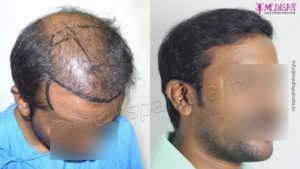The procedure of hair transplant is allowed to restore the natural hair from the area where it has been lost due to the genetic or a conditional hair loss. The hair transplant procedure is required to get back the original hair with all the aesthetic importance and one can receive it if possess a healthy donor area. However, it has great importance in the procedure that someone possessed the healthy donor area with a stable hair loss status. In order to receive the procedure, it is mandatory that patients having healthy donor areas, usually targeted from the back and sides of the scalp are resistant to the effect of DHT-sensitivity.
The only option to treat the Androgenic alopecia permanently is the hair transplant that involves the process of hair root transfer in which roots are extracted from the safe donor part, i.e., the back and sides of the scalp, and further transplanted to the areas where hair loss is occurring, known as the recipient balding part. The hair transplant is a single plastic & cosmetic surgery that allows the regrowth of hair and one can receive in order to get the best answer to the problem.
But, it is not always recommended due to the limits of the donor area, the occurrence of the autoimmune disorder as well as the responsible factor for causing the hair loss. Therefore, it is always advisable to receive the pre-procedure consultation in order to receive the best method as well as the treatment plan that further meets the aesthetic challenge of the procedure. The best hair transplant surgeon needs to be chosen as it assures about the best results.

hair transplants procedure
In this article, we are mentioning the factors that explain the hair restoration procedure needs in the light of criteria required for receiving the procedure are as follows: –
- The Androgenic alopecia: The Androgenic alopecia or the genetic baldness is the disease that occurs due to the combined effect of the genes and hormone that may accelerate due to the Androgen hormone, a male sex hormone that is a causative factor for presenting the case of genetic hair loss. The hair transplant is only a permanent option to treat the genetic hair loss that allows the possibility of regrowth of hair from the areas where it was lost. Thus, now it is not a question that how will you get the permanent hair after losing it and becoming a top demand in the cosmetic surgery world.
- The Donor Area: In order to receive the hair transplant procedure one must possess a safe and healthy donor area with full of hair to fulfil the need for the hair transplant procedure. The donor area is the occipital and parietal part of the scalp contains the DHT (Di-hydro Testosterone)-resistant hair roots that never show the effect of miniaturization or loss and thus primarily used in the hair transplant procedure. The procedure is absolutely allowed to treat the case of genetic baldness.
- The Stability concern of Hair Loss: The hair loss concern includes the factor of donor area stability as well as the hair loss status in terms of grade and stability concern. Usually, it has been seen that if a patient is affected by the genetic hair loss they have a gradual process of hair loss that extended with age and time. However, it is recommended to wait until you receive the maturity stage in terms of possessing the stable state of hair loss and the donor area. Normally, the surgical restoration is allowed after the age of 25 as the younger people tend towards the progressive hair loss that is needed to be noticed at the right time with the right treatment.
So, it is recommended to get the primary assessment in order to get the right treatment with the right technique.







